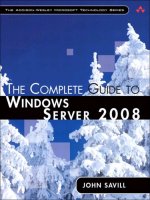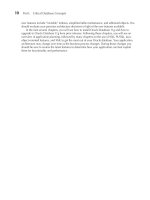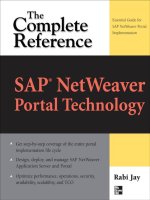The Complete FreeBSD potx
Bạn đang xem bản rút gọn của tài liệu. Xem và tải ngay bản đầy đủ của tài liệu tại đây (9.86 MB, 719 trang )
The Complete FreeBSD
®
If you find errorsinthis book, please report them to Greg Lehey <grog@Free-
BSD.org> for inclusion in the errata list.
The Complete FreeBSD
®
Fourth Edition
Tenth anniversary version, 24 February 2006
GregLehey
The Complete FreeBSD
®
by GregLehey <>
Copyright © 1996, 1997, 1999, 2002, 2003, 2006 by GregLehey. This book is licensed under the Creative
Commons “Attribution-NonCommercial-ShareAlike2.5” license. The full text is located at
are free:
• to copy, distribute, display,and perform the work
• to makederivative works
under the following conditions:
• Attribution. You must attribute the work in the manner specified by the author or licensor.
• Noncommercial. You may not use this work for commercial purposes.
This clause is modified from the original by the provision:
Yo umay use this book for commercial purposes if you pay me the sum of USD 20 per copyprinted (whether sold or not).
Youmust also agree to allowinspection of printing records and other material necessary to confirm the royalty sums.
The purpose of this clause is to makeitattractive tonegotiate sensible royalties before printing.
• Share Alike. If you alter,transform, or build upon this work, you may distribute the resulting work only
under a license identical to this one.
• Forany reuse or distribution, you must makeclear to others the license terms of this work.
• Anyofthese conditions can be waivedifyou get permission from the copyright holder.
Yo ur fair use and other rights are in no way affected by the above.
Parts of this book are derivedfrom the FreeBSD online handbook, which is subject to the BSD documentation
license reproduced on page xxxiv.
FreeBSD
®
is currently a registered trade mark of FreeBSD Inc. and Wind RiverSystems Inc. Changes are
planned; see for up-to-date information.
UNIX
®
is currently a registered trade mark of The Open Group. Formore information, see
in this book, UNIX refers to the
operating system development that predated the registration of the UNIX trademark.
Significant portions copyright © 1993, 1994, 1995 FreeBSD Inc.
Portions copyright © 1994, 1995 The XFree86 Project, Inc.
The Berkeleydaemon on the coverofthe print version was included with kind permission of M. Kirk
McKusick.
This book was written in troff and formatted on 25 February 2006 with GNU groff Version 1.19 running under
FreeBSD 6.0-CURRENT.
foo
β
foo
,page v
Contents
Foreword xxiv
Preface to the free edition xxvii
Building the book xxix
The status of this book xxx
Preface xxxi
The fourth edition xxxi
Conventions used in this book xxxii
Describing the keyboard xxxiii
Acknowledgments xxxiv
Book reviewers xxxv
Howthis book was written xxxvi
1: Introduction 1
Howtouse this book 1
FreeBSD features 4
Licensing conditions 6
Alittle history 7
The end of the UNIX wars 9
Other free UNIX-likeoperating systems 9
FreeBSD and Linux 10
FreeBSD system documentation 12
Reading online documentation 12
The online manual 13
GNU info 15
Other documentation on FreeBSD 16
The FreeBSD community 17
v
vi Contents
Mailing lists 17
Howtofollowuptoaquestion 20
Unsubscribing from the mailing lists 20
User groups 20
Reporting bugs 21
The Berkeleydaemon 21
2: Beforeyou install 25
Using old hardware 26
Device drivers 27
PC Hardware 28
Howthe system detects hardware 29
Configuring ISA cards 29
PCMCIA, PC Card and CardBus 30
PC Card and CardBus cards 31
Universal Serial Bus 31
Disks 32
Disk data layout 33
PC BIOS and disks 33
Disk partitioning 34
Block and character devices 36
Making the file systems 39
Disk size limitations 39
Display hardware 40
The hardware 41
The keyboard 41
The mouse 41
The display board and monitor 42
Laptop hardware 42
Compaq/Digital Alpha machines 42
The CD-ROM distribution 43
Installation CD-ROM 43
Live File System CD-ROM 46
CVS Repository CD-ROM 46
The Ports Collection CD-ROMs 46
3: Quick installation 47
Making things easy for yourself 47
FreeBSD on a disk with free space 48
FreeBSD shared with Microsoft 49
Configuring XFree86 50
The Complete FreeBSD" vii
4: Shared OS installation 51
Separate disks 51
Sharing a disk 52
Sharing with Linux or another BSD 52
Repartitioning with FIPS 52
Repartitioning—an example 54
5: Installing FreeBSD 59
Installing on the Intel i386 architecture 59
Booting to sysinstall 60
Kinds of installation 61
Setting installation options 62
Partitioning the disk 63
Shared partitions 66
Defining file systems 67
What partitions? 68
Howmuch swap space? 70
File systems on shared disks 75
Selecting distributions 75
Selecting the installation medium 76
Performing the installation 77
Installing on an Alpha system 78
Upgrading an old version of FreeBSD 79
Howtouninstall FreeBSD 79
If things go wrong 80
Problems with sysinstall 80
Problems with CD-ROM installation 80
Can’tboot 80
Incorrect boot installation 81
Geometry problems 81
System hangs during boot 82
System boots, but doesn’trun correctly 82
Root file system fills up 82
Panic 83
Fixing a broken installation 84
Alternative installation methods 85
Preparing boot floppies 85
Booting from floppy 86
Installing via ftp 86
Installing via ftp 87
Installing via NFS 88
Installing from a Microsoft partition 88
Creating floppies for a floppyinstallation 89
viii Contents
6: Post-installation configuration 91
Installing additional software 92
Instant workstation 93
Changing the default shell for root 94
Adding users 94
Setting the root password 95
Time zone 95
Network services 97
Setting up network interfaces 98
Other network options 99
Startup preferences 100
Configuring the mouse 101
Configuring X 102
Desktop configuration 108
Additional X configuration 108
Rebooting the newsystem 109
7: The tools of the trade 111
Users and groups 112
Gaining access 113
The KDE desktop 116
The Desktop Menu 116
The fvwm2 windowmanager 118
Starting fvwm2 119
Changing the X display 120
Selecting pixel depth 121
Getting a shell 121
Shell basics 122
Options 122
Shell parameters 123
Fields that can contain spaces 125
Files and file names 125
File names and extensions 126
Relative paths 126
Globbing characters 126
Input and output 127
Environment variables 128
Command line editing 131
Command history and other editing functions 133
Shell startup files 135
Changing your shell 136
Differences from Microsoft 138
Slashes: backward and forward 138
The Complete FreeBSD" ix
Tabcharacters 138
Carriage control characters 139
The Emacs editor 139
Stopping the system 141
8: Taking control 143
Users and groups 144
Choosing a user name 144
Adding users 145
The super user 146
Becoming super user 147
Adding or changing passwords 147
Processes 148
What processes do I have running? 149
What processes are running? 149
Daemons 150
cron 151
Processes in FreeBSD Release 5 152
top 152
Stopping processes 154
Timekeeping 155
The TZ environment variable 155
Keeping the correct time 156
Log files 157
Multiple processor support 159
PC Card devices 159
devd: The device daemon 159
Removing PC Card devices 161
Alternate PC Card code 161
Configuring PC Card devices at startup 161
Emulating other systems 162
Emulators and simulators 162
Emulating Linux 163
Running the Linux emulator 163
Linux procfs 164
Problems executing Linux binaries 164
Emulating SCO UNIX 164
Emulating Microsoft Windows 165
Accessing Microsoft files 165
xContents
9: The Ports Collection 167
Howtoinstall a package 168
Building a port 169
Installing ports during system installation 169
Installing ports from the first CD-ROM 169
Installing ports from the live file system CD-ROM 169
Getting newports 170
What’sinthat port? 172
Getting the source archive 173
Building the port 174
Port dependencies 174
Package documentation 174
Getting binary-only software 175
Maintaining ports 176
Upgrading ports 176
Using portupgrade 176
Controlling installed ports 178
Submitting a newport 180
10: File systems and devices 181
File permissions 181
Mandatory Access Control 186
Links 186
Directory hierarchy 187
Standard directories 187
File system types 190
Soft updates 191
Snapshots 191
Mounting file systems 192
Mounting files as file systems 193
Unmounting file systems 194
FreeBSD devices 195
OverviewofFreeBSD devices 195
Virtual terminals 197
Pseudo-terminals 197
11: Disks 199
Adding a hard disk 199
Disk hardware installation 200
Formatting the disk 203
Using sysinstall 204
The Complete FreeBSD" xi
Doing it the hard way 209
Creating a partition table 210
Labelling the disk 214
bsdlabel 215
Problems running bsdlabel 215
Creating file systems 216
Mounting the file systems 217
Moving file systems 217
Recovering from disk data errors 218
12: The Vinum Volume Manager 221
Vinum objects 221
Mapping disk space to plexes 222
Data integrity 223
Which plexorg anization? 224
Creating Vinum drives 225
Starting Vinum 225
Configuring Vinum 226
The configuration file 226
Creating a file system 227
Increased resilience: mirroring 228
Adding plexestoanexisting volume 229
Adding subdisks to existing plexes 230
Optimizing performance 232
Resilience and performance 233
Vinum configuration database 235
Installing FreeBSD on Vinum 236
Recovering from drive failures 240
Failed boot disk 241
Migrating Vinum to a newmachine 241
Things you shouldn’tdowith Vinum 241
13: Writing CD-Rs 243
Creating an ISO-9660 image 243
Testing the CD-R 245
Burning the CD-R 246
Burning a CD-R on an ATA burner 246
Burning a CD-R on a SCSI burner 248
Copying CD-ROMs 250
xii Contents
14: Tapes, backups and floppy disks 251
Backing up your data 251
What backup medium? 252
Tape devices 252
Backup software 253
tar 253
Using floppydisks under FreeBSD 256
Formatting a floppy 256
File systems on floppy 257
Microsoft file systems 258
Other uses of floppies 258
Accessing Microsoft floppies 259
15: Printers 263
Printer configuration 264
Testing the printer 265
Configuring /etc/printcap 265
Remote printing 266
Spooler filters 267
Starting the spooler 268
Testing the spooler 268
Troubleshooting 269
Using the spooler 270
Removing print jobs 271
PostScript 271
Viewing with gv 272
Printing with ghostscript 273
Which driver? 274
PDF 276
16: Networks and the Internet 277
Network layering 279
The link layer 280
The network layer 281
The transport layer 281
Port assignment and Internet services 283
Network connections 284
The physical network connection 285
Ethernet 286
HowEthernet works 287
Finding Ethernet addresses 289
The Complete FreeBSD" xiii
What systems are on that Ethernet? 290
Address classes 290
Unroutable addresses 291
Wireless LANs 291
Howwireless networks coexist 293
Encryption 293
The reference network 294
17: Configuring the local network 297
Network configuration with sysinstall 297
Manual network configuration 299
Describing your network 300
Checking the interface configuration 301
The configuration files 302
Automatic configuration with DHCP 302
DHCP client 302
DHCP server 303
Starting dhcpd 304
Configuring PC Card networking cards 304
Detaching network cards 306
Setting up wireless networking 306
What we can do now 307
Routing 307
Adding routes automatically 309
Adding routes manually 309
ISP’sroute setup 310
Looking at the routing tables 311
Flags 312
Packet forwarding 313
Configuration summary 313
18: Connecting to the Internet 315
The physical connection 315
Establishing yourself on the Internet 317
Which domain name? 317
Preparing for registration 318
Registering a domain name 318
Getting IP addresses 318
Choosing an Internet Service Provider 319
Who’sthat ISP? 319
Questions to ask an ISP 319
Making the connection 323
xiv Contents
19: Serial communications 325
Terminology 326
Asynchronous and synchronous communication 326
Asynchronous communication 326
Synchronous communication 327
Serial ports 327
Connecting to the port 328
When can I send data? 330
Modems 330
Modem speeds 331
Data compression 331
The link speed 332
Dialing out 333
Modem commands 333
Dialing out manually 335
Dialing out—an example 336
Dialing in 338
20: Configuring PPP 339
Quick setup 340
HowPPP works 340
The interfaces 340
Dialing 341
Negotiation 341
Who throws the first stone? 342
Authentication 343
Which IP addresses on the link? 344
The net mask for the link 346
Static and dynamic addresses 346
Setting a default route 347
Autodial 347
The information you need to know 347
Setting up user PPP 348
Setting up user PPP: the details 349
Negotiation 350
Requesting LQR 351
Authentication 351
Dynamic IP configuration 352
Running user PPP 353
Howlong do we stay connected? 353
Automating the process 354
Actions on connect and disconnect 355
If things go wrong 355
The Complete FreeBSD" xv
Setting up kernel PPP 355
Authentication 356
Dialing 357
Who throws the first stone? 358
Dynamic IP configuration 358
Running kernel PPP 358
Automating the process 359
Timeout parameters 359
Configuration summary 359
Actions on connect and disconnect 360
Things that can go wrong 361
Problems establishing a connection 361
21: The Domain Name Service 363
Domains and zones 364
Zones 365
Setting up a name server 365
Passive DNS usage 366
Name server on a standalone system 366
Name server on an end-user network 368
The SOArecord 368
The A records 369
The NS records 370
Nicknames 370
The MX records 370
The HINFO records 371
Putting it all together 371
Reverse lookup 372
The distant view: the outside world 373
The named.conf file 373
Slave name servers 376
The next leveldown: delegating zones 377
china.example.org 377
example.orgwith delegation 378
Messages from named 379
Upgrading a Version 4 configuration 380
Looking up DNS information 381
Checking DNS for correctness 382
DNS security 383
xvi Contents
22: Firewalls, IP aliasing and proxies 385
Security and firewalls 386
ipfw: defining access rules 386
Actions 388
Writing rules 388
Configuration files 389
Trying it out 393
IP aliasing 393
IP aliasing software 394
natd 395
Proxy servers 396
Installing squid 397
Starting squid 398
Browser proxy configuration 399
Setting proxy information for ftp 399
23: Network debugging 401
Howtoapproach network problems 401
Link layer problems 402
Network layer problems 406
traceroute 407
High packet loss 410
tcpdump 411
Packet loss revisited 412
Transport and application layers 414
Ethereal 414
24: Basic network access: clients 417
The World Wide Web 418
Webbrowsers 418
ssh 419
Access without a password 420
Creating and distributing keys 421
Authenticating automatically 422
Setting up X to use ssh 423
ssh tunnels 424
Tunneling X 425
Other uses of tunnels 425
Configuring ssh 425
Summary of files in ˜/.ssh 428
Troubleshooting ssh connections 428
The Complete FreeBSD" xvii
telnet 430
Secure telnet 431
Using telnet for other services 431
Copying files 432
scp 432
ftp 433
Specifying file names as URIs 434
Other ftp commands 434
mget 435
prompt 435
reget 436
user 436
sftp 437
rsync 437
Copying directory hierarchies 438
Using an rsync server 440
The Network File System 441
NFS client 442
Mounting remote file systems 442
Where to mount NFS file systems 444
Mounting NFS file systems automatically 445
NFS strangenesses 445
No devices 445
Just one file system 446
25: Basic network access: servers 447
Running servers from inetd 448
Configuring ftpd 450
anonymous ftp 450
Restricting access and logging 452
Running sshd 453
rsyncd 454
Setting up a web server 455
Configuring apache 455
The configuration file 456
httpd.conf 456
Virtual hosts 457
Log file format 459
Access control 460
Apache modules 462
Proxy web servers 462
Caching 462
Running apache 462
NFS server 463
xviii Contents
/etc/exports 463
Samba 464
Installing the Samba software 465
smbd and nmbd: the Samba daemons 466
The configuration file 466
Setting passwords 469
Testing the installation 469
Displaying Samba status 470
26: Electronic mail: clients 471
Mail formats 471
Mail user agents 472
mail 472
Other MUAs 473
Files, folders or directories? 473
mutt 474
Creating a newmessage 477
Replying to a message 478
Using folders 480
Deleting messages 481
Tagging messages 481
Configuring mutt 481
Colours in mutt 483
Mail aliases 484
Mail headers 484
Howtosend and reply to mail 487
Using MIME attachments 489
27: Electronic mail: servers 491
Howmail gets delivered 492
MTAfiles 492
Who gets the mail? 493
Postfix 493
Configuring postfix 494
Host and domain names 495
Relaying mail 496
Aliases revisited 496
Rejecting spam 498
Rejecting known spam domains 500
Rejecting sites without reverse lookup 501
Rejecting listed sites 501
Recognizing spoofed messages 501
The Complete FreeBSD" xix
Sender restrictions: summary 501
Running postfix at boot time 502
Talking to the MTA 502
Downloading mail from your ISP 503
POP: the Post Office Protocol 504
popper: the server 504
fetchmail: the client 504
Mailing lists: majordomo 505
28: XFree86 in depth 507
Xconfiguration: the theory 507
HowTVs and monitors work 508
Howmonitors differ from TVs 510
Howtofry your monitor 510
The CRTcontroller 511
The XF86Config mode line 513
XF86Config 516
The server layout 517
The Files section 517
The ServerFlags section 518
The Module section 518
The InputDevice section 519
The Monitor section 519
The Device section 520
The Screen section 521
Multiple monitors and servers 523
Multiple servers 523
Xinthe network 524
Multiple monitors across multiple servers 525
Stopping X 525
29: Starting and stopping the system 527
Starting the system 528
Things you can do before booting 529
What are you going to boot? 529
Loader commands 530
loader.conf 532
Loading other modules at boot time 532
Automatic kld load 533
Running the kernel 533
Single-user mode 540
Password protecting single-user mode 541
xx Contents
Shutting down and rebooting the system 541
FreeBSD without disks 542
Network booting 543
Setting up the file systems 544
Building a diskless kernel 544
Configuring TFTP 544
Configuring DHCP 545
Other Ethernet bootstraps 546
Configuring the machine 547
Sharing system files between multiple machines 548
Disk substitutes 549
30: FreeBSD configuration files 551
/etc/rc.conf 552
Our /etc/rc.conf 565
Files you need to change 566
/etc/exports 566
/etc/fstab 566
/etc/group 568
/etc/namedb/named.conf 568
/etc/mail 569
/etc/master.passwd 569
Files you might need to change 569
/etc/crontab 569
/etc/csh.cshrc, /etc/csh.login, /etc/csh.logout 569
/etc/dhclient.conf 569
/etc/disktab 569
/etc/ftpusers 570
/etc/hosts 570
/etc/hosts.equiv 570
/etc/hosts.lpd 570
/etc/inetd.conf 570
/etc/login.access 570
/etc/login.conf 571
/etc/motd 572
/etc/newsyslog.conf 572
/etc/nsswitch.conf 572
/etc/pccardd.conf 573
/etc/periodic.conf 573
/etc/printcap 573
/etc/profile 573
/etc/rc.firewall 573
/etc/resolv.conf 573
/etc/syslog.conf 573
The Complete FreeBSD" xxi
/etc/ttys 574
/boot/device.hints 575
Files you should not change 576
/etc/gettytab 576
/etc/manpath.config 577
/etc/netconfig 577
/etc/networks 577
/etc/passwd 577
/etc/protocols 577
/etc/pwd.db 577
/etc/rc 577
/etc/rc.i386 577
/etc/rc.network and /etc/rc.network6 578
/etc/rc.pccard 578
/etc/rc.serial 578
/etc/shells 578
/etc/services 578
/etc/spwd.db 578
/etc/termcap 578
/etc/periodic 578
Obsolete configuration files 579
/etc/host.conf 579
/etc/named.boot 579
/etc/netstart 579
/etc/sysconfig 579
31: Keeping up to date 581
FreeBSD releases and CVS 581
Symbolic names or tags 582
FreeBSD releases 582
FreeBSD-RELEASE 583
FreeBSD-STABLE 583
Security fix releases 583
FreeBSD-CURRENT 583
Getting updates from the Net 585
CVSup 585
Which CVSup server? 587
Running cvsup 587
Getting individual releases 587
Creating the source tree 588
Release tags 588
Updating an existing tree 591
Using a remote CVS tree 591
xxii Contents
32: Updating the system software 593
Upgrading kernel and userland 595
Upgrading the kernel 597
Upgrading the boot files 598
Upgrading the configuration files 599
Merging the password file 600
Merging /etc/group 602
Mergemaster,second time around 603
33: Custom kernels 607
Building a newkernel 608
Configuring I/O devices 609
The kernel build directory 609
The configuration file 610
Naming the kernel 611
Kernel options 612
Multiple processors 613
Debug options 614
Preparing for upgrades 617
Building and installing the newkernel 617
Rebooting 619
Making device nodes 620
Kernel loadable modules 620
sysctl 621
Living with FreeBSD-CURRENT 622
Build kernels with debug symbols 622
Solving problems in FreeBSD-CURRENT 622
Analyzing kernel crash dumps 623
Climbing through the stack 625
Finding out what really happened 626
A: Bibliography 628
Books on BSD 628
Users’ guides 629
Administrators’ guides 629
Programmers’ guides 630
Hardware reference 630
The 4.4BSD manuals 631
Getting FreeBSD on CD-ROM 631
The Complete FreeBSD" xxiii
B: The evolution of FreeBSD 635
FreeBSD Releases 1 and 2 635
FreeBSD Release 3 635
The CAM SCSI driver 636
Kernel loadable modules 637
The ELF object format 637
What happened to my libraries? 638
FreeBSD Version 4 640
No more block devices 642
NewATA (IDE) disk driver 643
Newconsole driver 643
FreeBSD Release 5 643
Index 645
xxiv Contents
(foreword.mm), page xxiv
Foreword
Ihav e been a long time developer of the BerkeleySoftware Distributions (BSD). My
involvement started in 1976, at the University of California at Berkeley. I got drawn in as
an office-mate of Bill Joy, who single-handedly wrote the code for BSD and then started
handling its release. Bill went on to run the Computer Systems Research Group (CSRG)
which developed and released the first fully complete BSD distributions. After Bill’s
departure to become a founder of Sun Microsystems, I eventually rose to head the CSRG
and oversee the release of the freely redistributable 4.4BSD-Lite. The 4.4BSD-Lite
distribution forms the basis for all the freely distributable variants of BSD today as well
as providing manyofthe utilities found in Linux and commercial UNIX distributions.
With the release of 4.4BSD-Lite, the University of California at Berkeleyceased further
BSD development. After considering the strengths and weaknesses of different BSD
development groups, I decided to do my continued development in FreeBSD because it
had the largest user community.For the past ten years, therefore, I have been a member of
the FreeBSD developer team.
Ihav e always felt that it is important to use your own product. For this reason, I have
always run BSD everywhere: on my workstation, on my Web/file/mail/backup server,on
my laptop, and on my firewall. By necessity,Ihav e to find tools to do my job that will run
on my BSD systems. It may be easier to just run Windows and PowerPoint to do your
presentations, but there are an everincreasing number of fine alternativesout there that
run on FreeBSD such as the open source OpenOffice.orgsuite or MagicPoint.
In the old days, there were not very manypeople working on the BSD software. This
constraint on BSD development made it easy to keep up with what BSD could do and
howtomanage your system. But the last decade has seen an exponential growth in the
open source movement. The result has been a huge increase in the number of people
working on FreeBSD and an evenlarger increase in the number of applications and tools
that have been ported to run on FreeBSD. It has become a more than full time job just to
keep track of all the system capabilities, let alone to figure out howtouse them all.
GregLeheyhas done a wonderful job with this book of helping those of us that want to
fully utilize the FreeBSD system to do so without having to devote our entire lives
figuring how. Hehas gone through and figured out each of the different tasks that you
xxiv
The Complete FreeBSD xxv
might ask your system to do. He has identified the software that you need to do the task.
He explains howtoconfigure it for your operational needs. He tells you howtomonitor
the resulting subsystem to makesure it is working as desired. And, he helps you to
identify and fix problems that arise.
The book starts with the basics of getting the FreeBSD system up and running on your
hardware, including laptops, workstations, and servers. It then explains howtocustomize
an installation for your personal needs. This personalization includes downloading and
operating the most important of the more than 8000 software packages in the FreeBSD
ports collection. The book also includes a very comprehensive set of systems
administration information, including the setup and operation of printers, local and
external networking, the domain name system, the NFS and Samba remote filesystems,
electronic mail, web surfing and hosting, and dial-up for FAX, remote login, and point-to-
point network connections.
In short, this book provides everything you need to knowabout the FreeBSD system from
the day you first pick up the software through the day you have a full suite of machines.
It covers your complete range of computing needs. There is a reason that this book is so
popular: as its title says, it is The Complete FreeBSD. I am very happytosee this revision
which once again fulfills that mandate.
Marshall Kirk McKusick
Berkeley, California
February 2003









